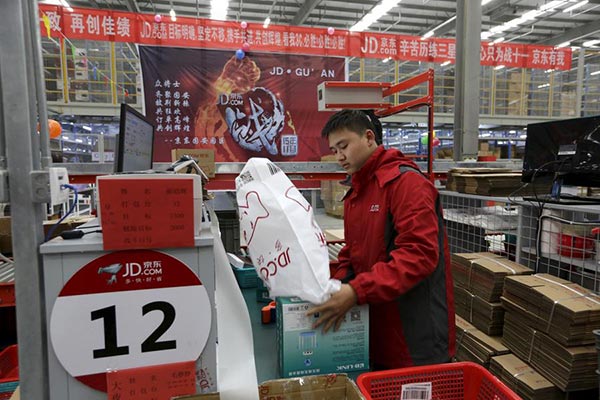The making of China's consumer society
Updated: 2016-09-05 07:27
By Andrew Sheng and Xiao Geng(China Daily)
|
|||||||||
 |
|
An employee works at a JD.com logistic centre in Langfang, Hebei province, November 10, 2015.[Photo/Agencies] |
China's transformation from a manufacturing-driven and export-led economy to one underpinned by services and domestic consumption is firmly underway. And that's good news not just for China, but also for the future of the global economy.
The 2016-17 edition of the Blue Book of China's Commercial Sector by Fung Business Intelligence and the Chinese Academy of Social Sciences maps the change. China's retail markets reached 30 trillion yuan ($4.6 trillion) in 2015, after more than a decade of double-digit growth. Household consumption has begun to climb, even as the pace of investment has fallen, and now exceeds 6 percent of GDP. Though the consumption growth rate has slowed to 10.7 percent, the Blue Book projects that China's domestic market may reach 50 trillion yuan by 2020.
A key driver of this transformation has been internet technology. Building on heavy investments in public infrastructure, such as ports, airports, roads, railways, and telecommunications, the internet is now expanding rapidly the range of choices available to Chinese consumers, while lowering costs and accelerating delivery.
As a result, China's online retail sales have surged in recent years, from 6.3 percent of total retail sales in 2012 to 12.9 percent by 2015. By 2020, 40 percent of all retail transactions in China may be conducted online. Online sales via mobile phones have jumped from only 1.5 percent in 2011 to 55.5 percent in 2015, and may reach 73.8 percent by 2018.
China has now overtaken the United States to build the world's largest online retail market. With a growth rate of some 33 percent, it is also the fastest-growing such market. And despite growth in internet use-the number of connected Chinese has risen from 253 million in 2008 to 688 million last year-there is plenty of room for further expansion.
This progress reflects innovations that enable broad-based consumption without the construction and maintenance of expensive brick-and-mortar outlets. In fact, growth in mobile sales has been driven by lower-income consumers, particularly in rural areas, where more than 81 percent of internet use occurs via mobile devices.
One key innovation has been multi-sided platforms like Alibaba, which, by providing access to production, logistics, distribution, and payments, challenge traditional business models-with considerable success. In the second quarter of 2016, Alibaba announced that its revenue from China's retail market had increased by 49 percent year-on-year; another online platform, Tencent, reported a 52 percent increase.
By connecting small and medium-sized enterprises (which account for 80 percent of employment in China) with the consumer base, such platforms erode some of the competitive advantage of large State-owned enterprises. Indeed, while the returns from China's internet retailing revolution have been highly concentrated, for once this concentration has not been in the State sector.
In online retailing via mobile devices, Alibaba held an 84.2 percent share of the market last year, with the next largest online retailer, JD.com, capturing just 5.7 percent. In the business-to-consumer market, Alibaba's Tmall claimed a 58 percent market share in the third quarter of 2015, with JD.com taking just 22.9 percent. In third-party online payment services, Alipay held 47.5 percent of the market, while Tenpay captured 20 percent, and UnionPay, the only service developed by the banking community, had 10.9 percent.
Related Stories
Over 700 Chinese companies take part in 2016 IFA consumer electronics fair 2016-09-03 20:59
Consumer-driven firms forge ahead in H1 2016-09-01 07:47
Consumer goods' quality to improve 2016-08-26 08:32
Consumer confidence, convenience really matter in online trade 2016-08-25 07:13
Top 10 largest consumer goods companies worldwide 2016-07-20 07:08
Ecommerce brings new business, opportunities to China Commodities City 2014-05-07 07:13
Today's Top News
'All policy tools' to aid growth push
Rocket explodes on launch pad
Mexico contradicts Trump on paying for border wall
British born Chinese face cultural challenge
UK house prices rise after Brexit hit
Brazil's Senate removes President Rousseff from office
EU to push for six priorities at G20 summit
Merkel opens Germany's 17th Confucius Institute
Hot Topics
Lunar probe , China growth forecasts, Emission rules get tougher, China seen through 'colored lens', International board,
Editor's Picks

|

|

|

|

|

|







